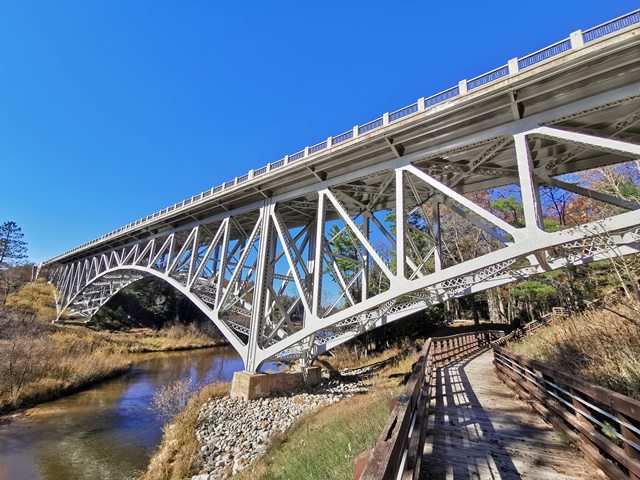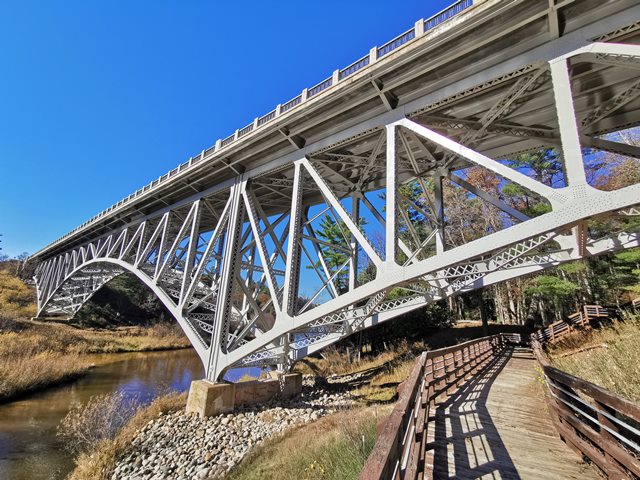We Recommend:
Bach Steel - Experts at historic truss bridge restoration.
Mortimer E. Cooley Bridge
M-55 Pine River Bridge

Primary Photographer(s): Nathan Holth
Bridge Documented: June 12, 2009, November 6, 2010, and October 29, 2022
Rural: Manistee County, Michigan: United States
1934 By Builder/Contractor: Wisconsin Bridge and Iron Company of Milwaukee, Wisconsin and Engineer/Design: Michigan State Highway Department
1989
300.0 Feet (91.4 Meters)
613.0 Feet (186.8 Meters)
30 Feet (9.14 Meters)
3 Main Span(s)
51151021000B030

View Information About HSR Ratings
Bridge Documentation
View Archived National Bridge Inventory Report - Has Additional Details and Evaluation
View Historical Articles About This Bridge

Unlike hillier states like Pennsylvania, Michigan does not have the massive, steep river valleys that required the construction of large high-level bridges in many locations. The Pine River, which is really a small creek cutting a large valley, is a notable exception. The only other bridge that compares to this structure is this bridge's larger and strikingly similar brother, the Cut River Bridge in the U.P.
The Cooley Bridge is nevertheless an impressive structure, and is among Michigan's rarest truss bridge types. It is highly attractive with most beams on the bridge being built-up with v-lacing and/or lattice. Similar to Cut River, there is a stairway that leads down beside the bridge for the purpose of viewing the bridge. The bridge always had stairways, suggesting that even when this bridge was built it was considered a noteworthy structure and attraction in Michigan. The fact that the bridge is today well-maintained and preserved is evidence that the bridge even today continues to be respected as a Michigan historic landmark and attraction.
This bridge was rehabbed and among the work done was MDOT's unique method of installing new railing posts with replicated architectural treatment, galvanizing and putting back into place the original railings which serve as sidewalk railings, and also placing low-profile crash-resistant "two tube" railing in front of the original railings for vehicles. This solution is a good solution that retains the aesthetic and historic qualities of the original railings, while also providing crash-resistant and AASHTO approved guardrails which do not overly obstruct the view of the bridge, original railings, or scenery from the bridge.
In 1935 the bridge won the American Institute of Steel Construction's Class C award for Most Beautiful Bridge, a noteworthy accomplishment, since AISC's awards are given only to a small number of bridges nationwide each year. A plaque on the bridge displays this information.
Information and Findings From Michigan Historic Bridge InventoryNarrative Description
The Mortimer E. Cooley Bridge is one of only two cantilevered deck truss bridges in Michigan. This structure is notable on aesthetic grounds as well, as the winner of the American Institute of Steel Construction Award in 1936 for the most beautiful structure in its class. This is also a large bridge, with an overall length of 555 feet. |
This bridge is tagged with the following special condition(s): Unorganized Photos
![]()
Photo Galleries and Videos: Mortimer E. Cooley Bridge
Bridge Photo-Documentation
Original / Full Size PhotosA collection of overview and detail photos. This gallery offers photos in the highest available resolution and file size in a touch-friendly popup viewer.
Alternatively, Browse Without Using Viewer
![]()
Bridge Photo-Documentation
Mobile Optimized PhotosA collection of overview and detail photos. This gallery features data-friendly, fast-loading photos in a touch-friendly popup viewer.
Alternatively, Browse Without Using Viewer
![]()
Additional Unorganized Photos
Original / Full Size PhotosA supplemental collection of photos that are from additional visit(s) to the bridge and have not been organized or captioned. This gallery offers photos in the highest available resolution and file size in a touch-friendly popup viewer.
Alternatively, Browse Without Using Viewer
![]()
Additional Unorganized Photos
Mobile Optimized PhotosA supplemental collection of photos that are from additional visit(s) to the bridge and have not been organized or captioned. This gallery features data-friendly, fast-loading photos in a touch-friendly popup viewer.
Alternatively, Browse Without Using Viewer
![]()
Maps and Links: Mortimer E. Cooley Bridge
Coordinates (Latitude, Longitude):
Search For Additional Bridge Listings:
Bridgehunter.com: View listed bridges within 0.5 miles (0.8 kilometers) of this bridge.
Bridgehunter.com: View listed bridges within 10 miles (16 kilometers) of this bridge.
Additional Maps:
Google Streetview (If Available)
GeoHack (Additional Links and Coordinates)
Apple Maps (Via DuckDuckGo Search)
Apple Maps (Apple devices only)
Android: Open Location In Your Map or GPS App
Flickr Gallery (Find Nearby Photos)
Wikimedia Commons (Find Nearby Photos)
Directions Via Sygic For Android
Directions Via Sygic For iOS and Android Dolphin Browser
USGS National Map (United States Only)
Historical USGS Topo Maps (United States Only)
Historic Aerials (United States Only)
CalTopo Maps (United States Only)




